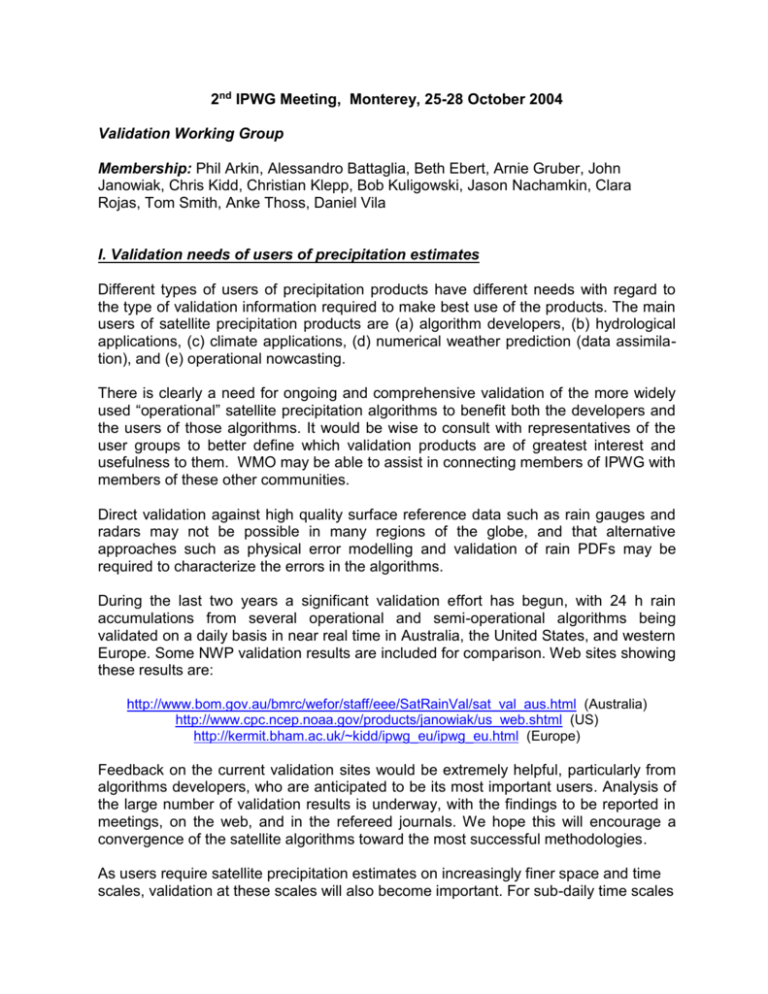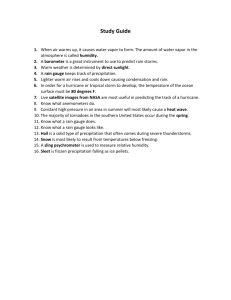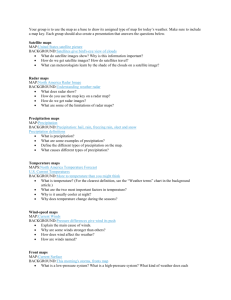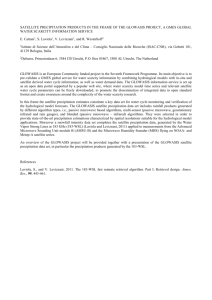2004 Validation Recommendations Actions
advertisement

2nd IPWG Meeting, Monterey, 25-28 October 2004 Validation Working Group Membership: Phil Arkin, Alessandro Battaglia, Beth Ebert, Arnie Gruber, John Janowiak, Chris Kidd, Christian Klepp, Bob Kuligowski, Jason Nachamkin, Clara Rojas, Tom Smith, Anke Thoss, Daniel Vila I. Validation needs of users of precipitation estimates Different types of users of precipitation products have different needs with regard to the type of validation information required to make best use of the products. The main users of satellite precipitation products are (a) algorithm developers, (b) hydrological applications, (c) climate applications, (d) numerical weather prediction (data assimilation), and (e) operational nowcasting. There is clearly a need for ongoing and comprehensive validation of the more widely used “operational” satellite precipitation algorithms to benefit both the developers and the users of those algorithms. It would be wise to consult with representatives of the user groups to better define which validation products are of greatest interest and usefulness to them. WMO may be able to assist in connecting members of IPWG with members of these other communities. Direct validation against high quality surface reference data such as rain gauges and radars may not be possible in many regions of the globe, and that alternative approaches such as physical error modelling and validation of rain PDFs may be required to characterize the errors in the algorithms. During the last two years a significant validation effort has begun, with 24 h rain accumulations from several operational and semi-operational algorithms being validated on a daily basis in near real time in Australia, the United States, and western Europe. Some NWP validation results are included for comparison. Web sites showing these results are: http://www.bom.gov.au/bmrc/wefor/staff/eee/SatRainVal/sat_val_aus.html (Australia) http://www.cpc.ncep.noaa.gov/products/janowiak/us_web.shtml (US) http://kermit.bham.ac.uk/~kidd/ipwg_eu/ipwg_eu.html (Europe) Feedback on the current validation sites would be extremely helpful, particularly from algorithms developers, who are anticipated to be its most important users. Analysis of the large number of validation results is underway, with the findings to be reported in meetings, on the web, and in the refereed journals. We hope this will encourage a convergence of the satellite algorithms toward the most successful methodologies. As users require satellite precipitation estimates on increasingly finer space and time scales, validation at these scales will also become important. For sub-daily time scales radar data is required for validation over large regions, but the errors associated with radar data are too great to accurately measures the satellite errors. For this, high quality gauge datasets (e.g. Oklahoma Mesonet, Korean gauge network) must be used. Both PDF (probabilistic) and traditional point-to-point validation methods may be appropriate, depending on the needs of the user. Some of the newer diagnostic validation techniques developed for mesoscale QPFs can be applied to satellite precipitation estimates. Recommendation 1: Provide baseline standards (i.e., a minimum set of metrics) for validating satellite precipitation algorithms that meet the needs of users in the algorithm development, NWP data assimilation, hydrology, climate, and nowcasting communities. Actions: Define validation metrics for algorithm developers – B. Ebert, J. Janowiak, C. Kidd Define validation metrics for NWP – E. Smith ???? Define validation metrics for hydrology – W. Krajewski CONTINUING???? Define validation metrics for climate – W. Berg ???? Define validation metrics for nowcasting – B. Ebert CONTINUING Recommendation 2: Encourage the inclusion of members of the NWP data assimilation, nowcasting, hydrology, and climate communities at future IPWG meetings, and encourage IPWG members to attend meetings of these user groups. Action: Deliver experts from user areas to next IPWG meeting - V. Levizzani, A. Gruber – Needs further improvement, CONTINUING Recommendation 3: Monitor performance of operational precipitation algorithms on a large scale on a daily basis, preferably in connection with NWP forecast validation. Validation metrics suggested by user groups (recommendation 1) should be considered for incorporation into the performance monitoring. Action: Implement new, and enhance existing, cooperative agreements between agencies providing satellite precipitation estimates and those with surface reference data, to perform ongoing validation of the satellite rainfall products - IPWG - CANCEL, significant progress has been made. Continue to monitor performance of operational precipitation algorithms on a large scale on a daily basis, in connection with NWP forecast validation. – B. Ebert, J. Janowiak, C. Kidd Standardize the information included in the daily validation products, including estimated and observed precipitation distribution "stripes" – B. Ebert, J. Janowiak, C. Kidd Create a survey form to collect feedback from developers and users on the daily algorithm validation. – B. Ebert, J. Janowiak, C. Kidd, A. Gruber Distribute survey directly to IPWG members, algorithm developers, specific users – D. Hinsman? Write news items for newsletters of relevant societies (e.g., BAMS, EOS) – C. Kidd, J. Janowiak, B. Ebert Recommendation 4: Support research on new error estimation approaches. II. Improvement of reference data sets used to validate precipitation estimates High quality reference datasets are necessary and important in being able to measure and characterize errors in the satellite precipitation estimates. Since no reference dataset is perfect, it is also necessary to understand the errors associated with the validation data itself. For rain gauge networks, the errors include instrument error, undercatch due to wind effects, and sampling and representativeness errors. Radar observations provide indirect measurements of rainfall, and are affected by beamfilling, attenuation, noise, calibration error, anomalous propagation, bright band contamination, and conversion of reflectivity to rain rate. To measure the errors in spatial rain estimates from gauge and radar data it is necessary to compare against an extremely high density gauge network. Studies of this nature are underway and are expected to provide valuable information on the nature of the errors in the reference data. Orographic precipitation, solid precipitation, and very light precipitation are types that are particularly difficult to measure, both for the satellite algorithms and for conventional instruments. Special datasets may be needed for validating these "difficult" types of precipitation, as rainfall measurements from the standard rain gauge and radar networks may not be sufficiently accurate to be useful. Some improvement is possible by adjusting gauge measurements for wind-related undercatch and including orographic enhancement effects in gauge analyses. There exist a number of good and high quality reference data sets, but they may be difficult to obtain in many cases. IPWG can play a role in making these data more widely available. It may be necessary in some cases to provide justification, i.e., the characterization of errors in satellite precipitation estimates. As routine error characterization of some future rainfall missions (GPM in particular) will be based on international partnerships with "supersites”, every effort should be made to make these data available to scientists. There is a strong need for reference data to validate oceanic satellite precipitation estimates. A small amount of coastal radar data is available (for example, both of the daily validations over the US and Europe use radar data that extend offshore) and could be used to validate mid-latitude oceanic estimates. Tropical rainfall measurements are available from the Pacific atoll rain gauge network, the TOGA/TAO and PIRATA moored buoys, and the Kwajalein radar; these have been used to validate satellite precipitation estimates in the past. Recommendation 5: Create an inventory of existing high quality reference data, and encourage the sharing of data from Intensive Observation Periods in large-scale experiments with the IPWG community to enable improved validation of satellite rainfall estimates. Actions: Determine the location and availability of rain gauge and radar data from national networks, international experiments, the Global Precipitation Climatology Center (GPCC), experimental test sites such as the Oklahoma Mesonet and TRMM validation sites, and oceanic rain gauge and radar networks. – M. Morrissey, C. Simmer, A. Thoss, B. Ebert CONTINUING – some progress Publish web links and contact information for obtaining these data on an IPWG web site. – M. Morrissey, C. Kidd, B. Kuligowski – CONTINUING Make contact with Steve Williams at the UCAR JOS, which keeps/accesses experimental data, to establish a web link with IPWG – B. Kuligowski IPWG members who are involved in such large-scale experiments as BALTEX, MAP, etc., should encourage the collectors of reference radar and gauge data to make these data available to the wider scientific community. – IPWG CONTINUING Recommendation 6: Investigate the quality and availability of surface reference networks for the validation of difficult (orographic, light, solid) precipitation. Actions: Investigate the possibility of obtaining precipitation measurements from Arctic and Antarctic networks - C. Simmer, B. Ebert CONTINUING Obtain transects of raingauge data from the NAME project via the UCAR JOS website – B. Kuligowski Obtain South American Monsoon Low Level Jet Experiment rain gauge data, which includes observations from the Andes – B. Kuligowski Obtain Canadian SNOWTEL snow gauge data from Paul Joe – C. Kidd Obtain Peruvian Andes and jungle rain gauge data – C. Rojas Recommendation 7: Develop new methods for characterizing the error of reference datasets, and for improving their reliability and quality using optimal network design. Actions: Continue to develop new methods for error characterization of reference datasets M. Morrissey, W. Krajewski CONTINUING?? Design criteria for improved rain gauge networks to address validation of remotely sensed rainfall estimates - W. Krajewski CONTINUING?? III. Communication Good communication among members and working groups of the IPWG is essential to its ability to function effectively and efficiently. Recommendation 8: Ensure that good communication among members of the IPWG is developed and maintained. Actions: Create and maintain a list server for IPWG and for the validation group - D. Hinsman - DONE Coordinate and track progress of the action items and activities of the Validation Group - B. Ebert - CONTINUING Recommendation 11: Develop an assessment software package, incorporating both basic and advanced techniques, to facilitate validation of satellite rainfall estimates by algorithm developers and users. Recommendation 9: Collaborate with other scientists and members of IPWG to expand the scope of current verification efforts, and enhance the ability of IPWG members to evaluate satellite precipitation estimates. Actions: Contact Ben Jong-Dao Jou (National Taiwan University) to see if he can contribute radar data for daily satellite algorithm validation. Contact Tomoo Ushio (Osaka Free University) and Toshiro Inoue (JMA) concerning daily satellite algorithm validation Instigate a web forum linking groups doing validation - B. Ebert - CONTINUING Items for CGMS (1) GPCP assessment A meeting was held in September to discuss the assessment of GPCP 2.5° monthly rainfall products and their suitability for climate research and change detection. A document is in preparation, with members of IPWG writing and reviewing the chapters. These authors and reviewers include members of the Validation Working Group. (2) Solid precipitation Theoretical and practical progress has been made on the ability to remotely sense solid precipitation (and liquid precipitation over land) using the 50 GHz and 118 GHz absorption bands. However, little progress has been made to advance the science of or acquire surface observations of solid precipitation in order to validate such satellite estimates. (3) Precipitation over complex terrain IPWG reported no major developments in the observation of precipitation over complex terrain. Observations will soon be available from two international experiments, the North American Monsoon Experiment (NAME) and the South American Monsoon Low Level Jet Experiment (SALJET), both of which will include rain gauge transects over mountainous terrain. (4) Ongoing validation activities During the last two years the IPWG has begun a program to routinely validate operational and semi-operational satellite precipitation algorithms against rain gauge and radar analyses over Australia, the United States, and western Europe. The results are updated daily and made available on the web. This program is a service to both algorithm providers and rainfall users, and will continue for some time into the future. A detailed analysis of the validation results is underway and the results will be published in refereed journals. High Resolution Precipitation Products The Validation Working Group supports the creation of a focus group to plan and execute the evaluation of high space/time resolution satellite precipitation products. One aim of this evaluation would be to provide a scientific basis for the choice and/or development of an "integrated precipitation product" by the Integrated Global Observing Strategy Partners (IGOSP). The membership of this group should include some members of IPWG, and should report back to IPWG at its next meeting.








